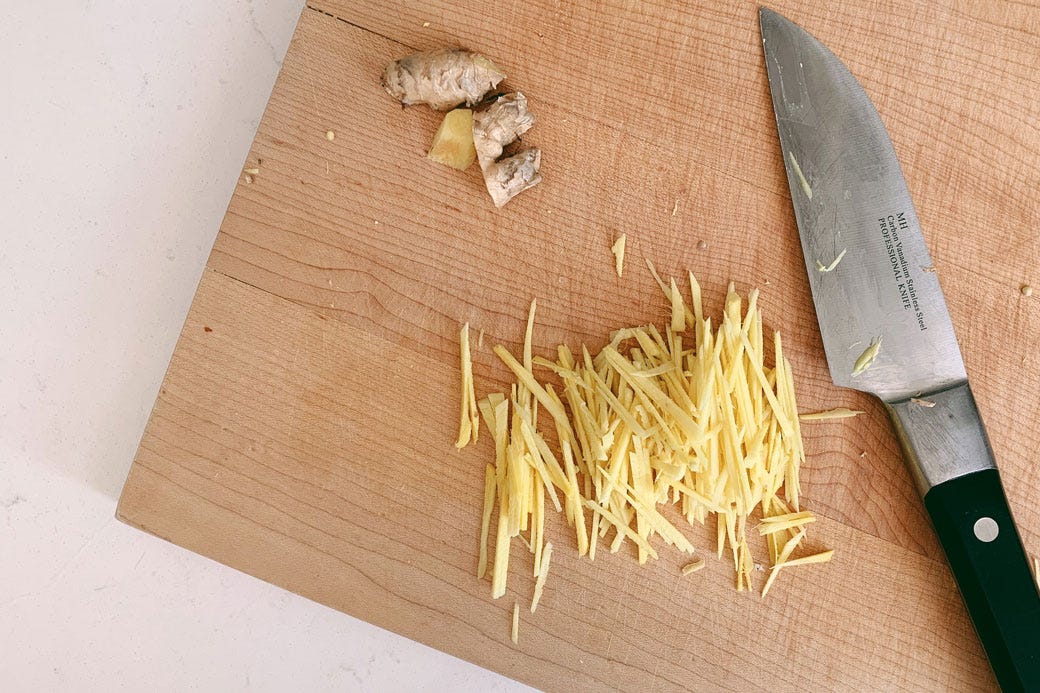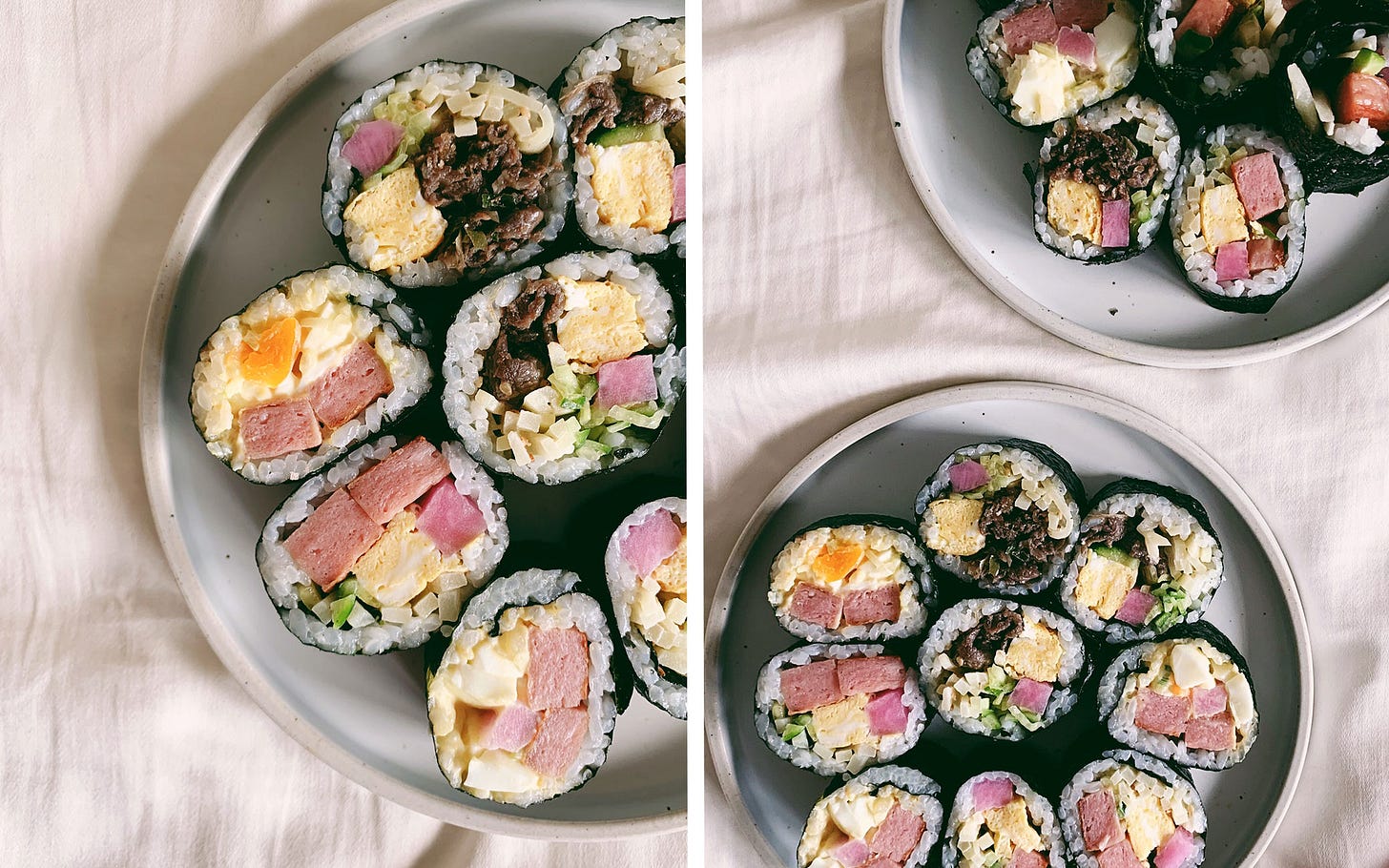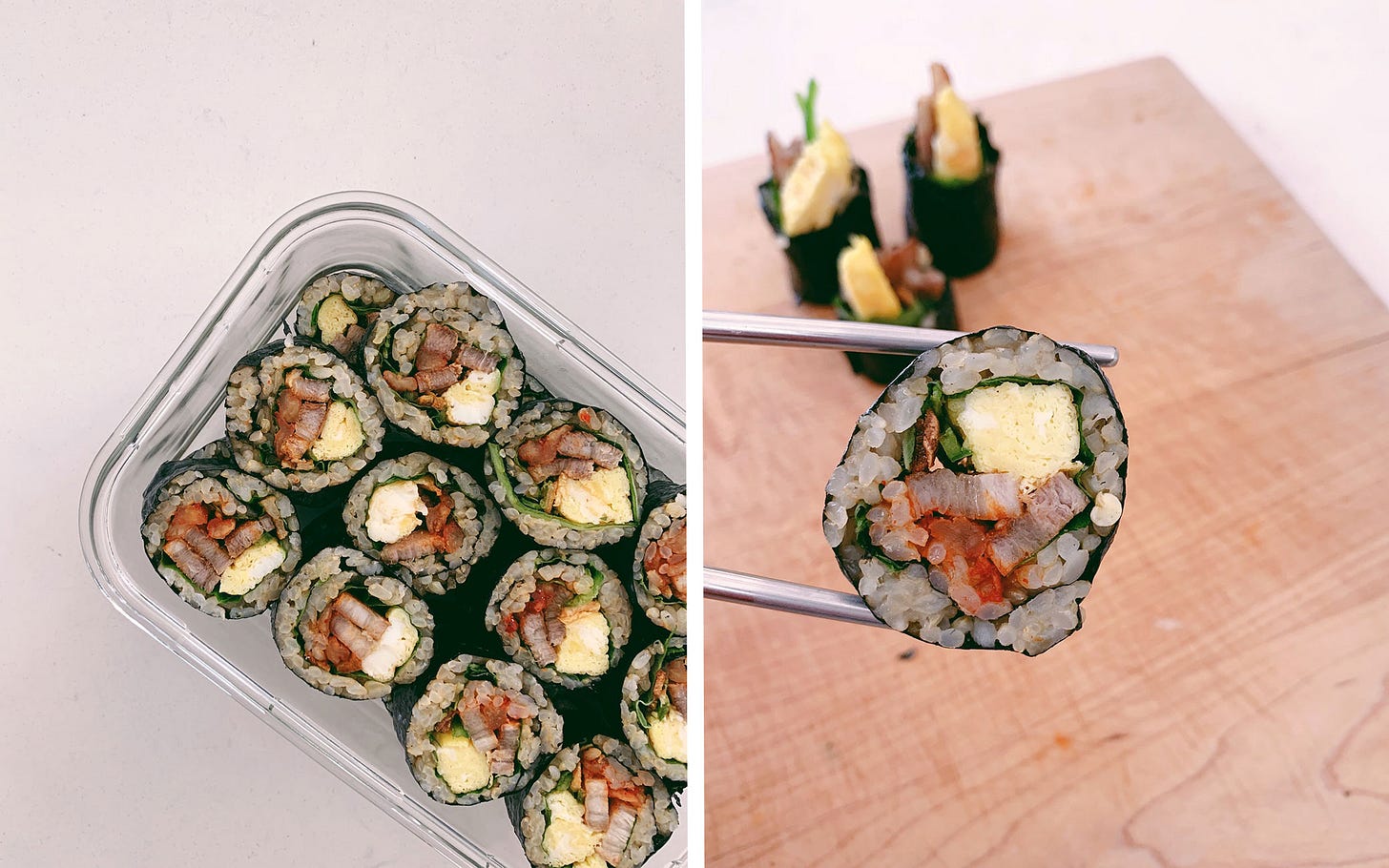


you know, it’s probably a bad idea to send out a substack on a sunday evening, but here it is, anyway!
i’ve been making a lot of kimbap this summer, which isn’t something i really did before. kimbap seems simple, and it’s not hard to make, per se — it’s just fairly labor intensive because there are a lot of parts to it. traditionally, i’d say kimbap is typically filled with a protein, carrots, cucumbers, danmuji (pickled daikon), egg, and spinach that has been blanched and seasoned. i don’t think i’m too far off when i say that many koreans and, even, korean americans of my generation think of kimbap nostalgically; it’s the food of road trips, ktown trips, anywhere trips.
of course, though, i’m going to follow that by saying that i don’t have much nostalgic attachment to kimbap. i ate it occasionally growing up, but it was never a food i thought that much about. i’ve always had a preference for gogi kimbap because i wasn’t a fan of odeng or eomook (i’d always push the odeng/eomook out before eating the rest of the kimbap). tuna kimbap was my second favorite. even with my strong preferences, to me, kimbap was kimbap, and kimbap was fine. it was honestly kind of uninteresting.
until kawi.
at momofuku kawi, chef eunjo park dedicates an entire part of the menu to kimbap. none of it is your typical kimbap — as is her style of korean american cooking, she keeps the structures of korean food intact while wildly reinventing and reimagining the internal. she has her signature kawibap, which she fills with two of her favorite banchans — stir-fried, candied anchovies and the softest omelet (i! want! her! secret!) — and serves with a side of uni and caviar. instead of using canned (or, even cooked) tuna, she makes her spicy tuna kimbap with generous slices of raw yellowfin tuna, tops it with scallions and tempura crunchies, and serves it with a delightfully spicy sauce. (when she says something is spicy, it’s spicy.)
once, she made this kimbap with white kimchi, cucumber, daikon, and pickled ginger, then topped it with spicy tuna tartare and boquerones. it was holy-shit amazing.
this is what makes her food so interesting — and what makes this new wave of korean american cooking in new york city so exciting. these chefs, whether we’re talking eunjo at kawi or jp park at atoboy/atomix or jae s. lee at nowon or douglas kim at jeju noodle bar or i could go on, they’re all taking korean food and doing something unique and individual with it. it’s all ridiculously delicious even if you don’t know where they’re coming from, but this new korean american cooking is just so much fun if you do.
and it annoys me that their cooking isn’t often put in the proper context for more people to pick up on these deeper cultural connections.
—
i miss momofuku. i think about momofuku a lot, and i’ve been picking up food from majordomo as often as i can. they’ve been doing mostly large format meals, though, that are often pork-y, which i don’t mind but my parents do. both factors have been limiting how often i can order from majordomo.
of course, as things go (and as i expected), while i’m in LA, momofuku started offering kimbap as part of their takeout menu at 207. i haven’t checked the 207 menu recently, but, a few weeks ago, they were offering kimbap two ways — the first a selection of some of park’s selected kimbaps and the second as a set of veggie kimbaps that came with various tartares you could use to top the kimbaps as you liked.
as fun as it has been to work on my kimbap-making and rolling technique, i am so jealous of anyone who got to eat these kimbaps. i talk about missing momofuku a lot, but most of that honestly is that i miss park’s food at kawi. momofuku as a whole means a tremendous amount to me, and it was personal to me long before kawi opened in march 2019, but kawi, y’all — i love kawi. i love what she’s doing there so much, and, no matter what happens to restaurants because of covid-19, i know she’s going to keep doing amazing, phenomenal things with korean food, and i’ll be that derp following her around wherever she goes because i believe in her and her vision for what korean american cooking is and can and will be.
—
want a random kimbap association?
kimbap often makes me think of shinhwa, an old-school k-pop boy band with six members that debuted in 1998. shinhwa is the longest-running boy band in k-pop, and, in 2012, they launched their own reality tv show called “신화방송” (“shinhwa broadcast”). in one episode, hyesung (main vocalist) wakes up early to make tuna kimbap for the other members. he’s excited to have them eat it, and they do so delicious and enthusiastically, only to confess later, after hyesung has left the room, that the kimbap was good but, omg, hyesung went ham with the sesame.
the show then cuts to shots of hyesung very generously pouring sesame oil and sesame seeds into whatever he can. he laughs and tells the camera he loves sesame — and, so, when i started making my own kimbap, i actually refused to season my rice because i liked it plain and i was also a little scared of overseasoning, which can be very easy to do. like, i love sesame, too, but i know too much of it can be sickening, so i didn’t start seasoning my rice until very recently.



last week, thomas keller’s TAK room in hudson yards announced that it would be permanently closing. eater ny followed news of the closure with a piece by critic ryan sutton in which he wrote that “culturally speaking, there isn’t much to mourn.” within a day or so, michelin-starred chefs were sharing the piece on social media and piling onto sutton, saying that he should have more sympathy for restaurant workers and basically kind of shitting on food media, on critics for not having worked in restaurants, etcetera.
the thing is — it’s not that sutton was rubbing the closure into the faces of workers who are out of work; trying to claim that was in incredible bad faith. he was, however, asking valid questions about money, class, and dining. the TAK room wasn’t serving food that was revolutionary or creative, instead seeking to appeal to a narrow group of wealthy [white] people who could afford the exorbitant prices. it’s worth asking whether or not that has value — or if it isn’t simply a show of wealth meant to cater to the elite while riding on the ego of a white male celebrity chef.
ultimately, the chef pile-on on social media seemed to come down more to this — that a bunch of chefs of really expensive, exclusive restaurants were upset that a critic dared to critique such a lionized figure in the culinary world. i’d go so far as to claim that many of these chefs likely practice and/or aspire to the elitism and classism keller represents, which means that people could ask of their restaurants, too, if they need to exist, if they contribute something of value to food, or if they are, in some ways, because of their exclusivity, culturally irrelevant.
that last bit is maybe an extreme; i do happen to see value in fine dining; and i think culture moves in many directions, which means that it does filter down. it’s why i don’t have too many issues with a lot of the new korean american cooking being on the pricier side — unfortunately, there is legitimacy to be gained in korean american cooking being recognized in these upper echelons, and that, i believe, will create more opportunities for korean american cooking at all levels.
however, whatever the restaurant or cuisine, i believe in rigorously questioning whether or not something needs to exist in the world. i think that applies even more so to things that are expensive and, thus, automatically work to keep most people away, and i think this chef pile-on goes to show how misplaced so many priorities are. keller will be fine, but his employees may not — and i don’t think the pandemic means anyone is immune from criticism. if anything, now is the time to hold people accountable. like, how are these chefs and restaurateurs actually going to support workers, pay them better, and provide them benefits? how are they going to try to make changes to create a more sustainable, equitable industry? how much of restaurateurs’ pleas to “save restaurants” serve them and their financial needs before their employees?
if covid-19 is doing something good, it’s exposing a lot of the bullshit we simply accepted. mandated work from home is showing that it is possible for many jobs to go remote, that the excuses companies gave were ableist discrimination. publishing going remote is demonstrating that, no, publishing does not have to be based in new york city, that it is possible for people to work from all over — but for publishing to open itself up to remote work is to make it more possible for people of color to qualify for jobs over white people. we’re seeing exactly who is essential to the survival of our communities, and they are grocery workers, healthcare workers, restaurant workers, a labor force traditionally considered to be “blue collar” and “low class” (aside from doctors and nurses), not to mention the workers who plant and harvest food, work in meathouses and dairy farms, and, in general, make sure our farmers markets and grocery stores don’t go empty.
of course, as our dumb society goes, none of this awareness is really causing actual change — like, god damn, when are we going to defund the police and start diverting that money back into schools so teachers can get paid what they deserve, have money to buy school supplies, and receive the support they need to do their jobs, which ultimately serves us all? when are we going to invest in our transportation and infrastructure? when will our damn government tax billionaires, none of whom truthfully should have that much wealth to begin with?
when are people going to stop protecting the wealthy and the egos of extremely privileged white men like thomas keller?


here’s another reason i don’t really mind that much of new korean american cooking is currently on the pricier end — there is still a prevalent notion that asian food needs to be cheap and grungy for it to be “authentic,” and that is, one, stupid, and, two, so very racist. this faux-authenticity has been a way of allowing eurocentric cuisines to remain in positions of power and authority, and it’s a mentality many diasporic asians have deeply internalized.
i certainly did. for many, many years, i was one of those dumbasses who would automatically write off any asian place that wasn’t “authentic.” the really dumb part of that was that i wasn’t knowledgeable enough really to know what “authentic” was because what other cuisine can i claim to know like i know korean food? i bought into it, though, this idea that the best pho came from grungy, noisy hole-in-the-walls where tabletops were a little sticky, utensils were gathered at the center of the table, and servers barely listened to your order while speaking loudly to each other in asian languages. yes, the food was delicious, but was it “authentic”? how would i know? and why did that matter so much?
food adapts — it has to. the immigrant cooking we get in america is one of adaptation, especially for immigrant cooking that exists in places where access to certain ingredients is incredibly limited. realizing this is why i no longer have much patience for people who shit on americanized chinese food or dishes like chicken tikka masala; no, they are not “authentic” in the racist way that white people use the word; but these are foods that came from immigrants and their need to survive in new places where their food, in their traditional forms, was unfamiliar to the mainstream. i don’t see that as something to look down on or condescend to. their success, rather, is maybe something to be celebrated instead, this immigrant tenacity to take something unfamiliar and make it theirs.
korean american cooking does something similar — korean american chefs take european techniques and disciplines and make them their own, applying these practices to food whose soul, ingredients, and flavors are all korean. entering the higher echelons of food — and kicking ass while doing so — is a direct way to challenge these racist standards that have long tried to keep “minority” cooking down by gatekeeping who is and who is not allowed respect and prestige.
neither of which, really, means that much on the face of things, but, in this dumb world we live in, this kind of recognition (aka the recognition of the michelin, james beard, blah blah blah) can make people step back and reconsider their prejudice, if only for a brief, fleeting moment. i know that also doesn’t mean much because racists will be racists and white people are all too happy to eat our food and appropriate it without ever seeing us as equal human beings, but i don’t think we can deny that prestige and recognition do provide a veneer of legitimacy — and the only reason i think that matters is that that opens up more space and more opportunity for a broader range of korean american cooking where creativity can flourish, korean americans can explore their identities on their own terms, and greater knowledge of korean food can spread.
—
i started making kimbap partly because i’ve been missing kawi so much. the kimbap i make is obviously very basic and nowhere near as creative or delicious as park’s, but it satisfies the itch. i’m flying back home to brooklyn on labor day, which means i may be eating at my first restaurant since lockdown because 207 has outdoor dining, and, omfg, i miss momofuku.







this is a free substack and will remain so for the near future. i’ve been thinking a lot about monetizing, but, at the moment, i enjoy having an outlet where i can do what i want — there’s tremendous value in having a space where i can basically play. as such, if you enjoy what you read and would like to buy me a cup of coffee because i put a tremendous amount of time and effort into each of these substacks, here are my venmo and ko-fi!

